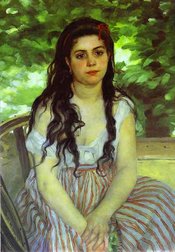Bohemianism
From Wikipedia, the free encyclopedia.
- For other uses, see Bohemian (disambiguation)
Though a Bohemian is a native of the Czech province of Bohemia, a secondary meaning for bohemian emerged in 19th century France. The term was used to describe artists, writers, and disenchanted people of all sorts who wished to live non-traditional lifestyles.
- "The term 'bohemian' has come to be very commonly accepted in our day as the description of a certain kind of literary gipsy, no matter in what language he speaks, or what city he inhabits .... A bohemian is simply an artist or littérateur who, consciously or unconsciously, secedes from conventionality in life and in art." (Westminster Review, 1862, noted at Online Etymology Dictionary.)
The term reflects the French perception, held since the 15th century, that the gypsies had come from Bohemia. Literary bohemians were associated in the French imagination with roving gypsies, outsiders apart from conventional society and untroubled by its disapproval. The term carries a connotation of arcane enlightenment (the opposite of 'Philistines'), and also carries a less frequently intended, pejorative connotation of carelessness with personal hygiene. Bohemians were often associated with drugs and self-induced poverty.
Henri Murger's collection of short stories, Scènes de la Vie de Bohème (Scenes of Bohemian Life), published in 1845, popularized the term's usage in France. Ideas from Murger's collection formed the theme of Giacomo Puccini's opera La bohème (1896).
In English, bohemian in this sense was first popularized in William Makepeace Thackeray's novel, Vanity Fair, published in 1848. Even the Spanish gypsy in a French opera Carmen set in Seville is referred to as a bohémienne in Meilhac and Halévy's libretto (1875).

The term has become associated with various artistic or academic communities and is used as a generalized adjective describing such people, environs, or situations: bohemian' (boho - informal) is defined in The American College Dictionary as "a person with artistic or intellectual tendencies, who lives and acts with no regard for conventional rules of behavior."
Many prominent European and American literary figures of the last 150 years belonged to the bohemian counterculture, and any comprehensive 'list of bohemians' would be tediously long. Bohemianism has been approved of by some bourgeois writers such as Honoré de Balzac, but most conservative cultural critics do not condone the bohemian lifestyle.
Bohemia meant any place where you could live and work cheaply, and behave unconventionally; a community of free souls far beyond the pale of respectable society. Bohemia flourished in many cities in the 19th and early 20th century — in Schwabing in Munich, Germany; Montmartre and Montparnasse in Paris, France; Greenwich Village in New York City, North Beach and later Haight-Ashbury in San Francisco, USA; and in Chelsea, Fitzrovia and Soho in London. Modern bohemias include Dali in China; Chiang Rai in Thailand; Kathmandu in Nepal; Amsterdam in the Netherlands; Prague in the Czech Republic; Užupis in Vilnius, Lithuania and Vama Veche in Romania
The current Broadway hit Rent is set in New York City and gives a glimpse into a more recent bohemia. This show was written by Jonathan Larson and is based on La bohème. One of the feature numbers, La Vie Boheme, addresses the death of bohemia as an end to the neighborhood as a haven for these bohemians, while celebrating the ideals and history that formed this counter-culture.

